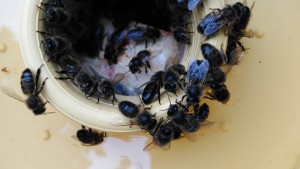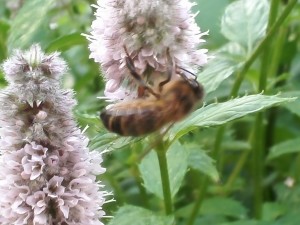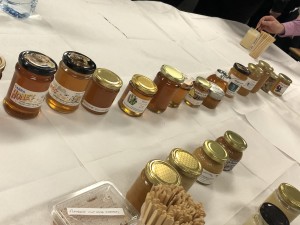People always say that you are what you eat. This is true for the honeybees too. Can you spot the difference of the following 2 groups of bees?
 My honeybees that were indulging themselves in sugar syrup
My honeybees that were indulging themselves in sugar syrup
You can see the difference? The healthy bees are brown and fluffy with yellow rings. While the bees that were eating sugar syrup are black and shiny that they almost lost their yellow rings on the abdomen.
What happened was the I staffed the “retirement home” for an old queen with perfectly healthy bees. And because they were put into a nuc with mostly empty frames that hadn’t got honey combs built, so I gave them extra care that was a sugar syrup feed. But the bees weren’t motivated to forage due to lack of pheromone from the aging queen, they just sat in their hive and ate the syrup. The food was an important factor that they changed their appearance. Compared to refined sugar, honey has a lot of more biological and chemical compounds that are good for the health. And the good news is that this is revertible! After the queen passed, I unites the bees back into a healthy hive and the black shiny bees disappeared.
Local honey is mostly produced by small scale beekeepers like me that turned a hobby into helping other people. People coming in to find honey for inconvenient conditions they have, like hey fever, throat infections, upset stomach etc. Generally local honey helps with these. Because local honey contains what is in the environment, like pollen, yeasts and phenolic acids, for example, that are antioxidant and can restore health. Most local honey is extracted at room temperature that preserves all the goodness. While in contrary, super market honeys are generally heated to filter through very fine filters to remove all the micro particles, which destroys the benefits that honey can bring.
Local honey can be good fun too. Because of the different forage and the strength of the bee colony, its taste varies from season to season. Even in the same apiary, different hives can produce different colored honey. Below is a photo from 2017 honey tasting night of Fingal Beekeeper’s association. It was a great night to taste honey of different flavors! So if you are getting my honey, you aren’t surprised to see that spring honey is lighter in color and softer, mild like Merlot, while the autumn honey is more like Cabernet Sauvignon that has a lot of structure.

